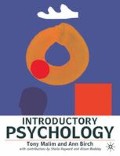Abstract
There are five major areas into which treatments are divided; these relate to the theories or assumptions of the five main approaches to psychology, as briefly described in the models or paradigms discussed in Chapter 32.
Preview
Unable to display preview. Download preview PDF.
Further reading
Axline, V. (1964). Dibs: In Search of Self. Harmondsworth: Penguin. A case study of a very disturbed child who was helped back to mental health through play therapy. The book offers strong support for psychoanalytic therapy.
Beck, A. and Emery, G. (1985). Anxiety Disorders and Phobias: A Cognitive Perspective. New York: Basic Books. A description of Beck’s theory and therapy to change thought processes, thereby enabling the reduction of anxiety and treatment of phobias.
Davison, G. and Neale, J. (1994). Abnormal Psychology, 6th edn. New York: Wiley. A very good, in-depth approach to all aspects of abnormality, including description, diagnosis and treatments.
Nutt, D.J. (1990) The Pharmacology of Human Anxiety, Pharamacological Therapies, 47, 223–266.
Rogers, C. (1961). On Becoming a Person. Boston, MA: Houghton Mifflin. Rogers’s own description of his beliefs, theory and therapy. The book also offers insights into the man himself.
Copyright information
© 1998 Tony Malim and Ann Birch
About this chapter
Cite this chapter
Malim, T., Birch, A. (1998). Treatments and therapies. In: Introductory Psychology. Palgrave, London. https://doi.org/10.1007/978-1-349-14186-9_40
Download citation
DOI: https://doi.org/10.1007/978-1-349-14186-9_40
Publisher Name: Palgrave, London
Print ISBN: 978-0-333-66852-8
Online ISBN: 978-1-349-14186-9
eBook Packages: Palgrave Religion & Philosophy CollectionPhilosophy and Religion (R0)

